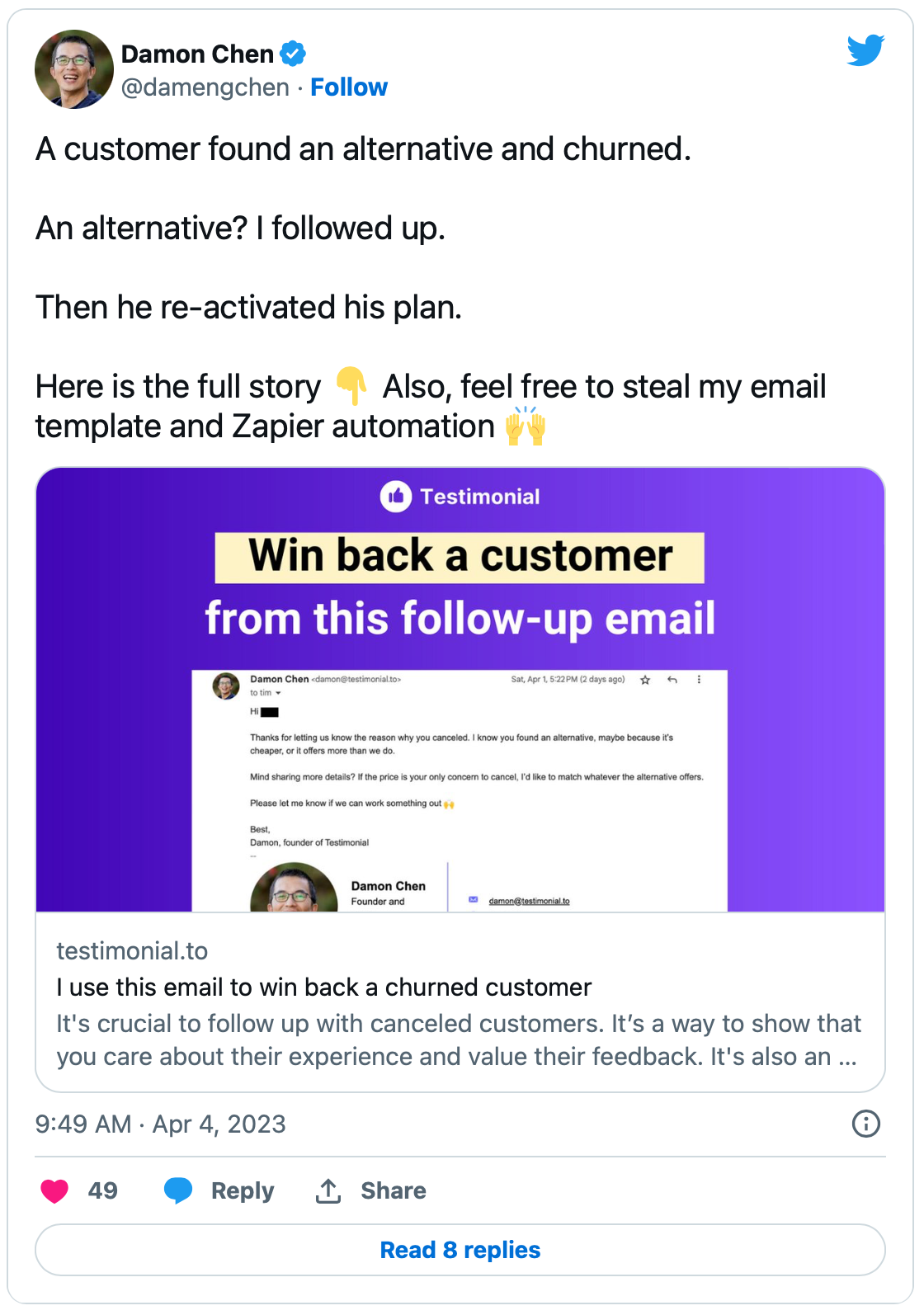Issue No. 14
Price by value delivered, not your effort to deliver
You SaaS is delivery value in time savings, expertise delivered, and more. You’re not selling the time to write the code and host your SaaS. You're free your customers to do what they care about.
Reading Time: 6 min

Source: DALLE, told to extract key phrases from this newsletter, create a prompt and using the style illustrative, colorful, futuristic create an image.
This week’s main topic is how to think about SaaS pricing.
What you’ll read this week:
- This week’s insight 👉 Use churn to your advantage
- The Main Topic → Price by value delivered, not your effort to deliver
- Boring SaaS Business Experiment Update, what’s happened in Week 2?
Enjoy!
🔹 This week’s insight 👉 Use churn to your advantage
Damon’s blog post is 🔥. Many times opportunities pass us by to make a connection or get valuable feedback from customers.
When Damon found out a customer churned, he reached out to him and found the customer left over price. The customer wasn’t aware of early business pricing and was trying out an inferior product over it.
Had Damon never emailed to discover why he’d lost the customer, he would have kissed those dollars goodbye forever. Lesson learned: every opportunity is a chance to learn; in this example, it saved a customer.

https://twitter.com/damengchen/status/1643294803369799680?s=20
🔹 Price by value delivered, not your effort to deliver
There’s a reason I like B2B SaaS over B2C. Businesses pay! Who doesn’t like to get paid?!
But a theme I often see in newer SaaS developers is a start under-appreciation of the value they’re delivering.
It’s like we sometimes don’t believe the value we deliver is worth someone else’s money.
So this week I thought I’d share some principles on pricing for newer indie hackers and maybe a refresher on some basics for those of us who’ve done it a time or two.
It seems to be a perennial problem for developers who turn to creating a SaaS. They undercharge.

https://twitter.com/FunnelLabMedia/status/1644756208069345280
Whatever the reasons, it’s something I hate to see. When you undercharge, you’re lowering your potential for success.
You’re,
- Potentially signaling to the market, you are a sub-par solution
- Leaving value on the table
- And limiting your potential (because let’s be frank when starting, every dollar matters).
So how can you avoid this?
Charge customers on the value you provide, not the effort or cost to deliver.
Here are some examples.
Example — Email Marketing Software
How much does it cost to send an email? Seriously? Nothing.
But they’re not selling that.
They’re selling convenience, time saved, expertise on delivery rates, automation, and more. That’s worth more than nothing, isn’t it?
It sure is. ConvertKit charges me $29 per month for my list. Worth it for my starting newsletter “empire”? Absolutely.
Why? Because of the value and time saved, it lets me focus my time and energy on building ProductFoundry. Leaving me not have to worry about email delivery, scheduling emails
Example — Time Tracking Software Value
There are a lot of these solutions on the market. One of my teams has used 3-4 solutions in the last few years.
What’s it take to build a time-tracking SaaS? Not all that much, and today it cost pennies to host.
But, the value of a solution tuned to my industry? To my needs? So I don’t have to have employees inconvenienced trying to send emails or update a shared spreadsheet. As a boss, not having to compile timesheets manually for clients is a ton of value. To send invoices and collect payments? Priceless (well, maybe it does have a ceiling 😉).
But that’s worth more than a couple of bucks a month, right?
Does a company like Harvest (a popular solution in this space) charge $10/mo? Or $25/mo flat?
Nope, they charge $12/user/month. For a small team of only ten, that’s $120 a month or $1,440 a year.
The examples are endless. Every SaaS out there today is delivering value in time savings, expertise delivered, and more. You’re not selling the time to write the code and host your SaaS. You’re providing value that your customers can’t or don’t want to do themselves. You’re freeing them up to do what they care about.
So how should I think about charging?
I’m not a fan of making things complicated. And making pricing confusing will scare customers away. If you’re new to SaaS, here are some simple concepts to follow.
KISS — Keep it simple (stupid)
You don’t need to go recreate pricing or worry about how much to charge. Just look at what other SaaS are doing and charging and copy them. Compete on value delivered, not price.
Default to Pricing Transparency
This goes along with KISS; customers don’t like fancy and hate not knowing how much they’ll be charged in the future. You don’t need fancy pricing tier names. Make your pricing clear and easy to understand. Help people figure out what’s best for them. Help them see where if they grow, their price will grow as well.
Premium Pricing — You may not feel your day-1 SaaS is worth a premium price. That’s fine, and maybe it’s true. But don’t sell yourself short and position yourself as a cheap solution. You’ll keep iterating. I’m sure you’ll have a premium product in a year.
Still, feel like you can’t charge a premium? (but seriously, why doubt yourself?!) put up premium prices and offer an early subscriber discount.
Remember, niches generally allow for higher prices — The more general your solution, the cheaper the price. For a variety of reasons, this is usually true. General purpose solutions, with broad appeal, tend to charge less (there are exceptions for sure, especially in enterprise pricing).
But consider AI today. What sounds like it delivers more value and sells to an audience willing to pay more? A general-purpose ChatGPT app that lets you do Q&A? Or a ChatGPT solution that helps lawyers quickly understand and deconstruct a legal contract? Definitely the latter.
Common Pricing Structures
There are only a few standard ways (and thus comfortable for customers) to charge.
- Flat pricing (aka one size fits all)
- I’m not a fan of this. It’s more common in B2C.
- Tiers
- This is by far the most common
- You’ll commonly see three tiers, maybe with a freemium one upfront.
- Generally, the tiers are a mix of features and usage-based, charging more for advanced features or more users
- Usage Based
- Some solutions make sense to charge not by tiers but by usage.
- CPU time, memory, disk space, and emails sent are all good examples.
- Customers generally don’t mind when it’s clear their service will cost you more.
- I’m not a fan of usage-based alone. Team it up with something...
And, of course, you can mix things up:
- Tiers + Usage
- You have a few tiers and a separate usage cost that goes up.
- Or more tightly combine them, and the per/usage fee is more expensive per tier.
- If it makes sense for your solution, this is one of my favorite pricing schemes. A two-axis pricing solution maximizes your opportunity, and as long as it’s straightforward, customers don’t mind.
- Flat + Usage
- Have a base usage cost and mostly charge by usage.
- If you’re determined to charge on usage, put a flat fee up front. Even $5 bucks goes a long way to your bottom line.
🔹 Boring SaaS Business Experiment Update
It’s week 2 of my Boring SaaS Experiment. And this week’s update is going to be very short.
My day job was my night and weekend job this last week. Gotta pay the bills, and I fully believe that you deliver yourself 100%. So I had to take a week off from working on things.
A bummer, but this reminds me of a conversation I had on Twitter yesterday.

Here’s what I shared with Peter.
- Recognize what fills you. Do more of that.
- Listen to your emotions, if you’re feeling fatigued, you’re probably not doing enough of #1.
- Surround yourself with like-minded others to cheer you on.
- Evaluate what you’ve committed to. Opportunity cost is a thing; you can’t be the be all and end all for everything.
The last one is the salient one here. Starting something on the side comes at a cost. It’s a balance you have to evaluate continually.
For me, this week, it was the thing that had to give. And I’m okay with that.
Join the ProductFoundry Newsletter
Signup for insights into making great SaaS products and companies.